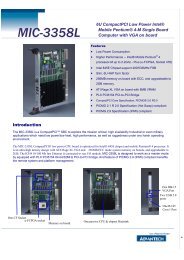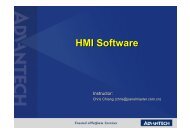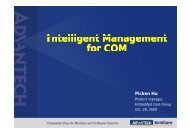industrial wireless book special edition - Networking ...
industrial wireless book special edition - Networking ...
industrial wireless book special edition - Networking ...
Create successful ePaper yourself
Turn your PDF publications into a flip-book with our unique Google optimized e-Paper software.
RFID technology<br />
Active RFID tags have an onboard battery to power the microchip’s circuitry and transmit signals to<br />
readers. Typically, active tags can be read from distances of around 30m. They also allow more<br />
applications by offering two-way communications, sensor integration, independent system<br />
intelligence, and constant viability. Active RFID tags work using Received Signal Strength Indication<br />
(RSSI) or Time Difference of Arrival (TDOA) technologies.<br />
RSSI: Some tags associate with APs to provide a regular beacon or ‘chirp’ (a 416-bit 802.11 frame).<br />
This reduces tag/AP interaction to a simple unidirectional packet – there is no state for the AP to maintain<br />
and no IP address required. Also, less radio time means a longer battery life. This is common amongst<br />
IEEE 802.11 <strong>wireless</strong> protocol families, whether a, b, g or the newer n flavour. Other tags send out a<br />
more constant signal, become associated with the AP, providing a more constant awareness with<br />
stronger integration. However, battery life is shorter.<br />
In an 802.11 Wi-Fi network, the APs are arranged so that they receive signals from the RFID tag and<br />
triangulate its position based on the received signal strength at each AP. The stronger the signal, the<br />
closer the tag is to the AP. Each AP sends it’s strength metric to the <strong>wireless</strong> control system, which<br />
interprets the signal strength via an appliance and middleware. This provides coordinates via APIs to<br />
user interface software, which – in turn – specifies location. The results can be sent as coordinates<br />
or shown on a visual map.<br />
For Lightweight Access Point Protocol (LWAPP) environments, location information is sent to the Location<br />
Appliance and Wireless Control System (WCS) rather than an alternative separate non-LWAPP engine,<br />
which can also calculate tag positions. Accuracy can be 2 – 3m, depending on environment, location<br />
and AP density.<br />
TDOA: This is similar to RSSI in that the network APs triangulate tag locations based upon the signal,<br />
but here it is the time it takes for the signal packet(s) to arrive at the AP that is important. The shorter<br />
the time taken for the signals to be detected, the closer the tag is to the AP, and a position is estimated<br />
using one or more locating algorithms in the location appliance and WCS. This method is more resilient<br />
for high ceilings and outdoor applications, and is less disturbed by building structures.<br />
In another application there are chokepoints (‘exciters’). This works using strategically placed readers<br />
or triggering devices – the exciters. When a tag passes within range of a 125 kHz exciter, the tag emits<br />
a short burst of Wi-Fi data that includes that exciter’s unique identification. With an exciter, immediate<br />
tag recognition occurs as the tag is ‘excited’ and emits a response. Conventionally, it can take several<br />
minutes before tags chirp and the location is updated. Exciters, therefore, provide a more real-time<br />
experience for tracking moving items. Additionally, tags can be set to turn themselves on or off as they<br />
go through chokepoints.<br />
In summary, RSSI is good for most indoor tracking applications and uses existing standards-based Wi-<br />
Fi networks. TDOA uses a more proprietary approach, but can be backhauled via Wi-Fi networks and<br />
is good for outdoor and difficult environments. Choke-points are good for tracking movement of assets<br />
through doorways and designated areas, so helping to prevent asset loss or tracking mislaid items.<br />
Organisations that define standards and regulate the use of RFID include ISO, IEC, ASTM International,<br />
DASH7 Alliance and EPCglobal.<br />
Open standards platforms<br />
With different protocols and standards abounding,<br />
a key technology development has been the introduction<br />
of open standards based platforms.<br />
The pace of adoption is starting to pick up.<br />
The customer stories below tell the business<br />
benefits side, but there are also IT and process<br />
benefits. With an open-standards WCS4, the<br />
application can integrate with warehouse, ERP<br />
and other business systems. Tracking WIP can<br />
become part of the overall methods of manufacture,<br />
not only for the supply chain, but also<br />
plant-floor activities, such as MES and WIP.<br />
Challenges remain. Firstly, manufacturers want<br />
reliable and available systems. A system is now<br />
available that uses a <strong>wireless</strong> interference<br />
monitoring technology. This comprises <strong>special</strong><br />
hardware built into certain APs, plus advanced<br />
interference identification algorithms that<br />
automatically detect radio interference and can<br />
map its source, rather like an integral spectrum<br />
analyser. Microwave and blue-tooth devices,<br />
for example, can cause interference. The system<br />
identifies the interference and detects where<br />
it’s coming from and can mitigate it, providing<br />
a more reliable network.<br />
Secondly, 802.11n adoption continues to<br />
grow. These are higher performance than the<br />
older networks, but manufacturers’ IT departments<br />
may still have legacy deployments, so<br />
technologies are still needed to cope with both<br />
old and new. There are ways of improving the<br />
network performance of legacy 802.11a and g<br />
devices (older Wi-Fi networks), whilst still<br />
enjoying the benefits of a higher performance<br />
802.11n Wi-Fi network.<br />
sponsored by Advantech<br />
<strong>industrial</strong> ethernet <strong>book</strong>

















